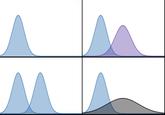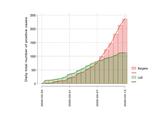#FlattenTheCurve
Confirmed 13,221
Part of a series on COVID-19 Pandemic. [View Related Entries]
#FlattenTheCurve
Part of a series on COVID-19 Pandemic. [View Related Entries]
For up-to-date information regarding COVID-19 coronavirus, including prevention and treatment, please visit CDC.gov.
Overview
#FlattenTheCurve, also known as Flatten the Curve, refers to a viral campaign to encourage people to take steps to slow the spread of the Coronavirus. The name comes from a bell-curve graph illustrating the difference in the spread of a viral outbreak when a society takes preventative measures vs. when it doesn't. When it doesn't, the outbreak can affect more people and overwhelm the health care system's capacity to treat everyone. In the graph, this is represented by a sharp curve. When society takes preventative measures, the outbreak does not affect as many people at once and health care systems can adequately handle the outbreak. This is represented by a "flatter" curve.
Background
On February 28th, 2020, Twitter user @drewaharris[1] posted a graph representing how an outbreak looks when a society takes preventative measures vs. when it doesn't. The society that takes preventative measures does not overwhelm the health care system (shown below).

Developments
On March 6th, 2020, Twitter user @CT_Bergstrom praised the graphic in a Twitter thread,[2] gaining over 10,000 retweets and 15,000 likes (shown below, left). He wrote, "This single picture explains the concept of flattening the epidemic curve to non-specialists without requiring any additional text. Looking at the picture, you can see that even if you don't reduce total cases, slowing down the rate of an epidemic can be critical." The graphic caused "#FlattenTheCurve" to trend as people took the image to heart and created variations. For example, user @SiouxsieW[3] posted a GIF representing the concept, gaining over 10,000 retweets and 12,000 likes (shown below, right).


The term became a widely written-about means of mitigating the epidemic, having been covered by Vox,[4] The New York Times,[5] CBS[6] and others. The popularity of the term led #FlattenTheCurve to trend, as people recommended "social distancing" tactics, such as working from homes and not going to large events to help prevent the spread of the virus. For example, Twitter user @Sci_Phile[7] joked, "It’s finally not rude to cancel your plans," gaining over 160 retweets and 950 likes (shown below, left). User @deboevep[8] posted an image of matches meant to illustrate the concept, gaining over 200 retweets and 500 likes (shown below, right).


Search Interest
External References
[1] Twitter – drewaharris
[2] Twitter – @CT_Bergstrom
[3] Twitter – @SiouxsieW
[4] Vox – How canceled events and self-quarantines save lives, in one chart
[5] New York Times – Flattening the Coronavirus Curve
[6] CBS – Flattening the curve Why we need to cancel everything and stay home to help stop coronavirus














Comments ( 24 )
Sorry, but you must activate your account to post a comment.
Please check your email for your activation code.